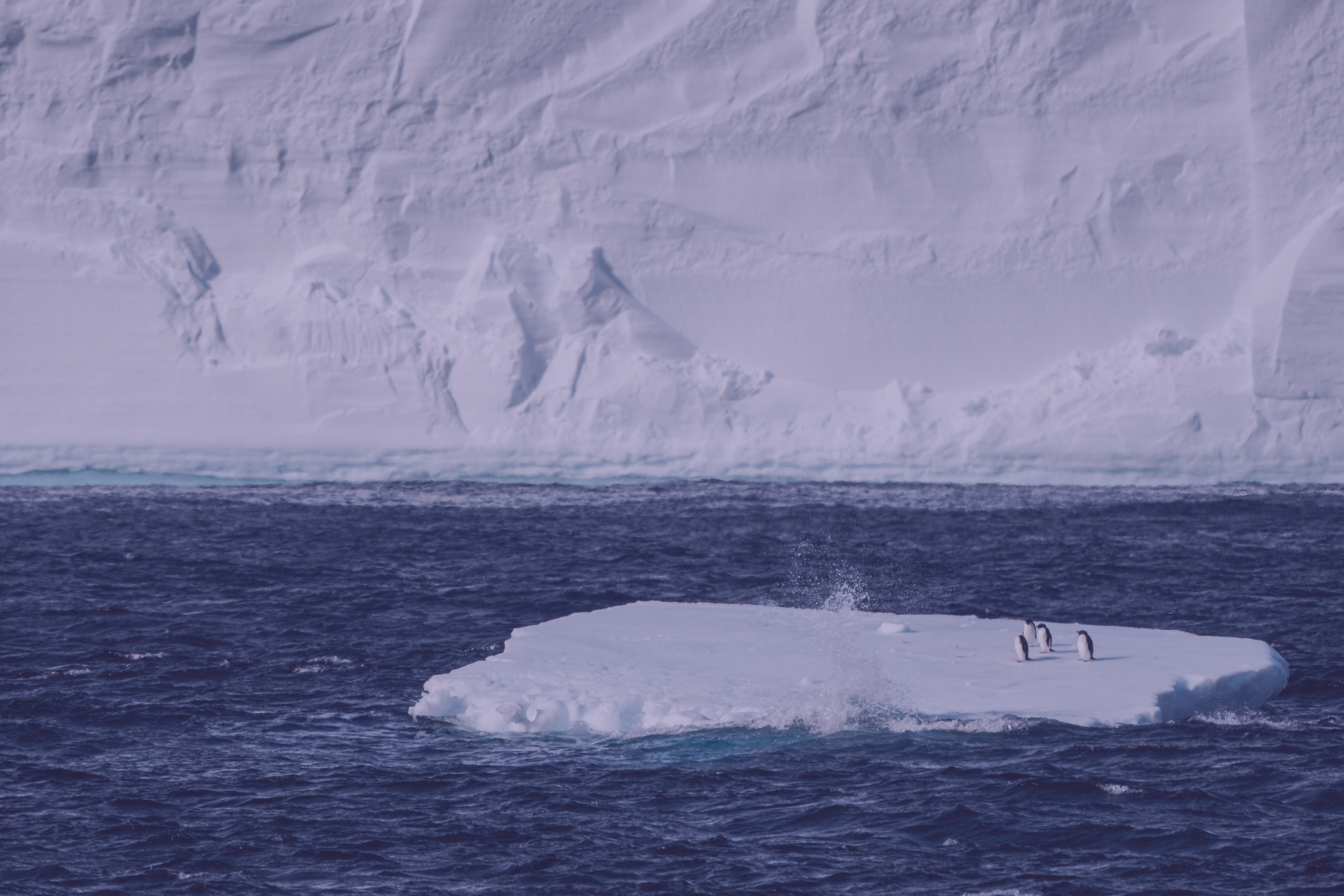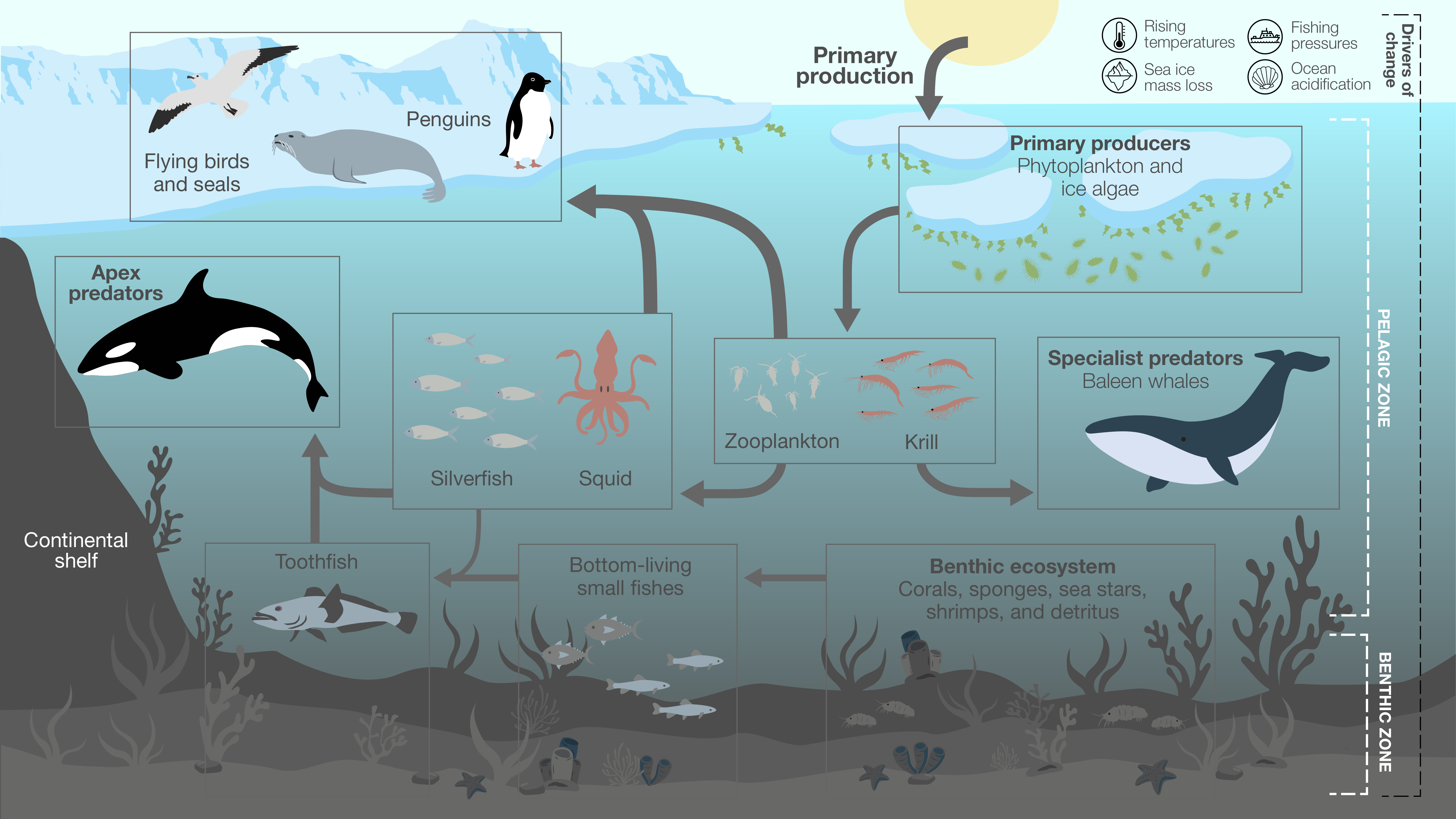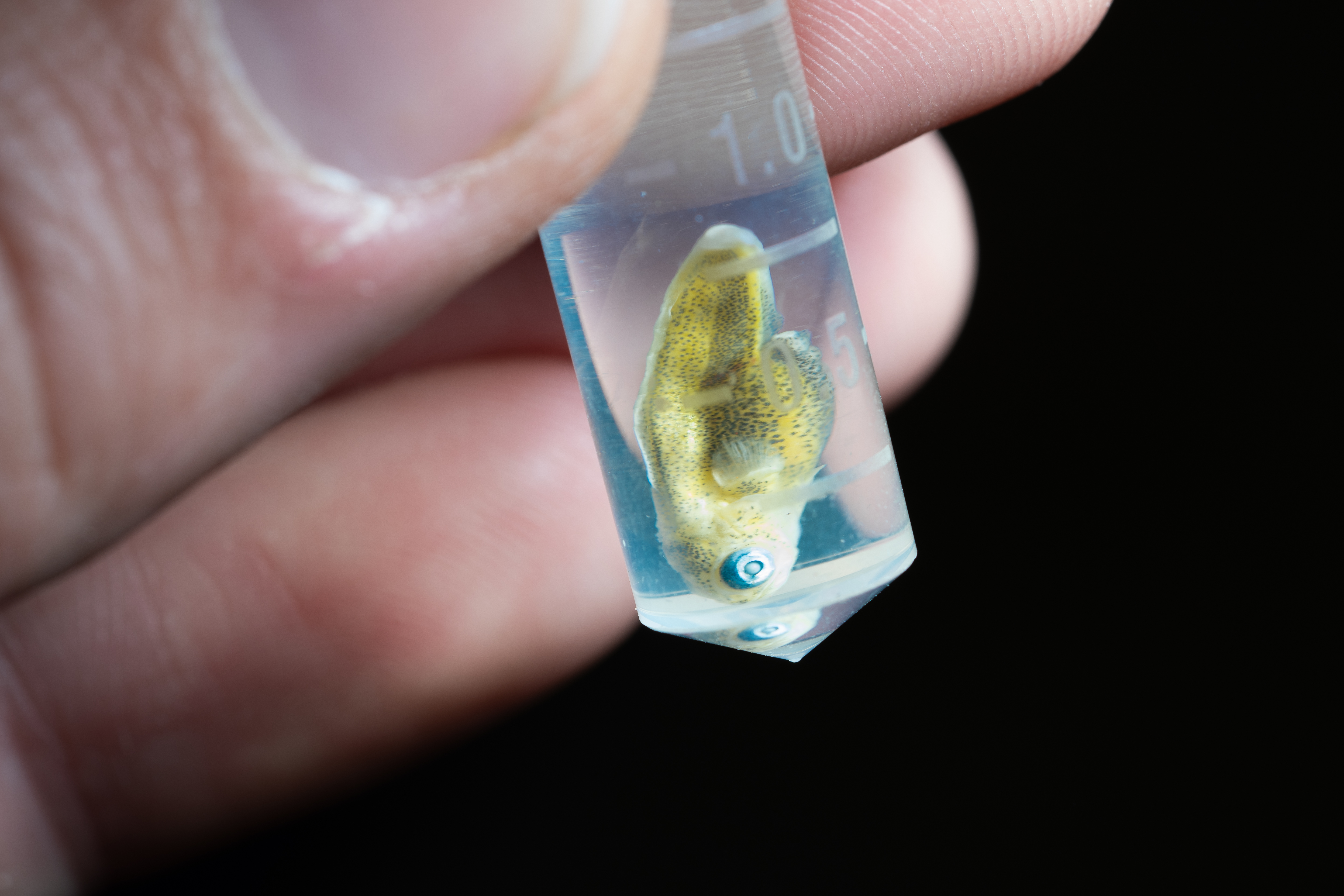
Life in a changing ocean: pelagic species in Antarctica's Ross Sea
The oceans around Antarctica are home to complex and productive ecosystems. These ecosystems are characterised by species found nowhere else in the world and a food web specially-adapted to the extreme environment. The Southern Ocean ecosystem is under pressure from fishing and a changing climate. In future, we expect the surface waters around Antarctica to be warmer and fresher (less salty), sea ice to decline, and the ocean currents to strengthen. Understanding how these changes will impact ocean productivity and ‘keystone’ species (those especially important in the food web) will help the international community prepare for, and respond to, these changes.
This summary
This summary aims to inform policy makers and scientific peers about pelagic research conducted in the Ross Sea region by New Zealand’s Antarctic Science Platform (ASP).
This research synthesis:
- shares information about primary production (the growth of tiny algae that absorb sunlight) and the pelagic food web of the Ross Sea region
- highlights the effects of a changing climate on pelagic species and communities in the Ross Sea region
- provides critical baselines and new insights to understand pelagic biodiversity and biogeography in a warming world
- supports the application of research by domestic and international stakeholders and collaborators to advance environmental management and promote ecosystem resilience.
Key points
- Modelling and measurements show that growth rates of Antarctic phytoplankton and sea-ice algae will be affected by climate change. We’ve developed new ways to use satellite images to anticipate and observe these changes.
- Impacts of changes in production of phytoplankton and sea-ice algae will cascade through the marine food web.
- Sea ice is a crucial habitat for ‘keystone’ groups of organisms including small midwater fish, krill, and mesozooplankton. These groups have special ecological importance in the Antarctic marine environment where they act as a ‘buffer’ between climate effects and higher-level predators, like seabirds, marine mammals and large fish, like toothfish.
- We’ve developed field techniques and instruments, including new eDNA sampling approaches for analysis of species presence and genetic diversity, and a giant sea-ice corer to sample animals in platelet ice.
- The Ross Sea region Marine Protected Area (MPA) can help fishing for Antarctic toothfish to be done with less risk to other species.
Pelagic ecology research

Figure 1: The flow of energy, captured through primary production, through the pelagic ecosystem and beyond.
Pelagic research and food web insights guide marine management
Our research on Antarctica’s pelagic ecosystem has helped to support New Zealand’s strategic commitment to:
- sustainable stewardship of the Ross Sea region
- supporting the Ross Sea region Marine Protected Area
- identifying and minimising threats related to fishing.
New Zealand is committed to delivering research to help evaluate the conservation value of the Ross Sea region Marine Protected Area (MPA). New Zealand and USA jointly proposed this MPA to the international Commission for the Conservation of Antarctic Marine Living Resources (CCAMLR) and it was established by unanimous vote in 2017.
CCAMLR is responsible for ensuring Antarctic fishing is sustainable, reversible, and does not harm associated species. In the Ross Sea region, fishing toothfish was started by New Zealand in 1997, and now involves over 10 countries, catching about 3,000 tonnes of toothfish each year. The MPA was designed to make sure fishing in the Ross Sea stays within biological limits, even as the area is affected by climate change.
The Ross Sea region MPA relies on research to understand how it’s performing. We need high-quality data on the population dynamics of key species and their inter-dependencies to ensure that the ‘top-down’ effects of fishing on the Ross Sea food web do not compromise ecological resilience. This need for better data presents significant scientific challenges, but also provides an opportunity. By studying how large, open-ocean ecosystems respond to fishing and climate change, our pelagic food web research helps CCAMLR to improve the management of the toothfish fishery in the Ross Sea region and elsewhere.
Our research on Southern Ocean ecosystems helped to establish a new SCAR action group on Antarctic fish: SCARFISH. New Zealand has positions on the SCARFISH executive committee and joint leadership of the working group for biogeography, modelling, and management.

Photo: Lana Young
Contact information
Matt Pinkerton
Principal Scientist - Marine Ecology, Earth Sciences NZ
Definitions:
Benthic environment: the seabed and its inhabitants.
Pelagic environment: organisms and environments in the open ocean, away from the shore or seabed.
Primary production: growth of phytoplankton in the water column by photosynthesis.
References
Behrens E, Grüss A, Pinkerton M, Parker S, Rickard G, Stevens C (2024). Tropical teleconnections through the Amundsen Sea Low impact Antarctic toothfish recruitment within the Ross Gyre. Scientific Reports 14(1): 26715. https://doi.org/10.1038/s41598-024-78248-y
Bury SJ, Peters KJ, Sabadel AJM, St John Glew K, Trueman C, Wunder MB, Cobain MRD, Schmitt N, Donnelly D, Magozzi S, Owen K, Brown JCS, Escobar‑Flores P, Constantine R, O’Driscoll RL, Double M, Gales N, Childerhouse S, Pinkerton MH (2024). Southern Ocean humpback whale trophic ecology. I. Combining multiple stable isotope methods elucidates diet, trophic position and foraging areas. Marine Ecology Progress Series 734: 123–155. https://doi.org/10.3354/meps14532
Cristi A, Law CS, Pinkerton M, Lopes dos Santos A, Safi K, Gutiérrez‑Rodríguez A (2024). Environmental driving forces and phytoplankton diversity across the Ross Sea region during a summer–autumn transition. Limnology & Oceanography 69(4): 772–788. https://doi.org/10.1002/lno.12526
Hayward A, Pinkerton MH, Gutiérrez‑Rodríguez A (2023). Phytoclass: a pigment‑based chemotaxonomic method to determine the biomass of phytoplankton classes. Limnology & Oceanography: Methods 21(4): 220–241. https://doi.org/10.1002/lom3.10541
Hayward A, Pinkerton MH, Wright SW, Hinz DJ, Gall M (2024). Twenty‑six years of phytoplankton pigments reveal a circumpolar Class Divide around the Southern Ocean. Communications Earth & Environment 5: 92. https://doi.org/10.1038/s43247-024-01261-6
Johnston NM, Murphy EJ, Atkinson A, Constable AJ, Cotté C, Cox M, Daly KL, Driscoll R, Flores H, Halfter S, Henschke N, Hill SL, Höfer J, Hunt BPV, Kawaguchi S, Lindsay D, Liszka C, Loeb V, Manno C, Meyer B, Pakhomov EA, Pinkerton MH, Reiss CS, Richerson K, Smith WO Jr, Steinberg DK, Swadling KM, Tarling GA, Thorpe SE, Veytia D, Ward P, Weldrick CK, Yang G (2022). Status, change, and futures of zooplankton in the Southern Ocean. Frontiers in Ecology and Evolution 9: 624692. https://doi.org/10.3389/fevo.2021.624692
McCormack SA, Melbourne‑Thomas J, Trebilco R, Griffith G, Hill SL, Hoover C, Johnston NM, Marina TI, Murphy EJ, Pakhomov EA, Pinkerton MH, Plagányi É, Saravia LA, Subramaniam RC, Van de Putte AP, Constable AJ (2021). Southern Ocean food web modelling: progress, prognoses, and future priorities for research and policy makers. Frontiers in Ecology and Evolution 9: 624763.
Pinkerton MH, Hayward A (2021). Estimating variability and long-term change in sea ice primary productivity using a satellite-based light penetration index. Journal of Marine Systems 221: 103576. https://doi.org/10.1016/j.jmarsys.2021.103576
Pinkerton MH, Halfter S, Stewart R, Robinson KV (2024). Continuous Plankton Recorder sampling of zooplankton and microplastic in the Southern Ocean 2002 to 2023 with special focus on the Ross Sea sector. New Zealand Aquatic Environment and Biodiversity Report 347: 101
Rickard GJ, Behrens E, Bahamondes Dominguez AA, Pinkerton MH (2023). An assessment of the oceanic physical and biogeochemical components of CMIP5 and CMIP6 models for the Ross Sea region. Journal of Geophysical Research: Oceans 128(3): e2022JC018880. https://doi.org/10.1029/2022JC018880
Stevens DW, Braid HE, Meynier L, Escobar‑Flores PC, Pinkerton MH, Hopcroft D, He Y, Cherel Y (2024). A guide to the otoliths of Southern Ocean lanternfishes (Myctophidae). Polar Biology 47(12): 1543–1558. https://doi.org/10.1007/s00300-024-03312-2